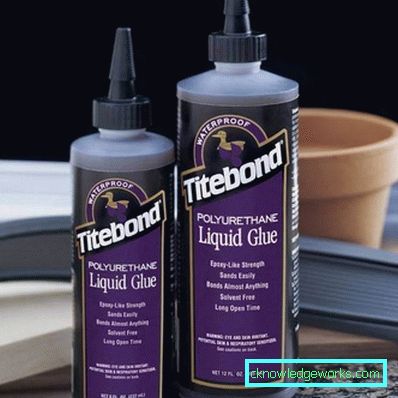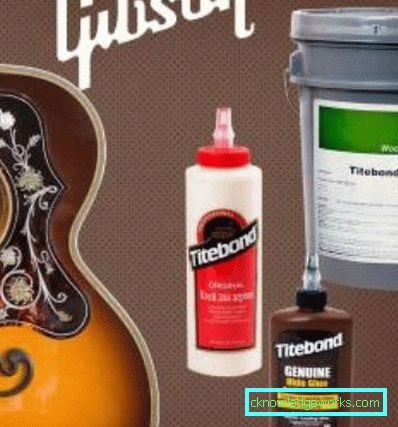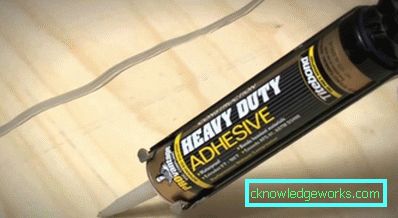Titebond wood glue
Titebond wood glue: characteristics, consumption and application

Titebond wood glue, produced by the American concern Franklin International, is widely known to Russian consumers. The company is a recognized leader in the production of professional carpentry and operates for 80 years. Products are manufactured according to AFG-1 standards, which guarantees its high quality and reliability. Relying on many years of experience and realizing innovative technologies, the company offers a wide range of woodworking, restoration and parquet adhesives, produced on high-tech equipment and meeting modern trends in household and construction chemicals.

Composition and properties
Titebond glue is a professional carpentry tool that has found wide application not only in production, but also in everyday life. The composition of the adhesive is represented by aliphatic resins, polymers, polyurethanes, protein, synthetic rubber and water. The material is not an abrasive tool that guarantees the safety of the cutting tool when cutting products.
In the liquid state, the adhesive is characterized by stable chemical viscosity due to the strong cross-links of the mixture. This prevents its excessive fluidity and greatly simplifies installation.


After drying, the composition becomes quite resistant to negative temperatures., that allows you to use the tool for the repair and manufacture of items, the operation of which will be carried out in outdoor conditions. Despite the thermal stability of the composition and its ability to tolerate temperature exposure to 40 degrees, it should be remembered that with increasing thermo-mode to +100 degrees, the glue is able to ignite and sustain burning. Titebond tolerates solvent effects and can be easily removed from the surface before drying. The initial setting time of the glue is 10 minutes, the viscosity of the composition is 4,000 mPa / s. PH value is 3 units.
The dry residue after drying is equal to half of the original volume. At observance of storage conditions, the composition is suitable for use within two years after opening the bottle. The optimum temperature for bonding is + 10–12 degrees. Adhesive consumption varies from 170 to 190 g / sq. It depends on the environmental conditions and the degree of porosity of the wooden surface.

Advantages and disadvantages
High consumer demand and a large number of positive reviews about Titebond wood glue due to the indisputable advantages of this composition:
- the presence of a world-class certificate indicates the high quality of the material and suggests its use as a professional tool;
- mechanical strength of the seam being formed is several times higher than the strength of wood;
- The adhesive is environmentally safe and non-toxic, which allows the use of glued products in residential and public buildings without restriction;
- the durability of the compound makes it possible to use glue in furniture production and construction;
- the composition does not stick to metal surfaces, which greatly facilitates the selection of tools and care for them.


The disadvantages of joinery glue include the impossibility of joining wet and painted parts, as well as the need to respect the temperature conditions in the room during installation.
Scope of use
The scope of Titebond glue is quite extensive. The tool can be applied to wood of any age and species. It is perfect for gluing laminate, plywood, cardboard and paper in any combination. In the woodworking industry, the composition is indispensable in the manufacture of furniture, decorative flooring and doors. In the field of design, glue is often used for artistic decoration of interior items with elements of wood, and during repairs often acts as a sealant for sealing joints. One of the modifications of the glue is specially created for the manufacture and repair of musical instruments. Due to its high moisture-resistant qualities, lack of abrasive effect and good resistance to mechanical loads, the composition is widely used for veneering MDF and chipboard, repairing school and home furniture, as well as a means for restoring antiquities, wooden souvenirs and household utensils.




Varieties
The range of joinery has about 25 types of glue, represented by several series.
- Original wood glue 5064 473 ml is available in red packaging and is used for the production of musical instruments. Due to the particularly hard polymerization structure, the tool does not affect their sound and can be used for both wind and string versions.


- Titebond II Premium 5004 - This is a one-component moisture-resistant composition, produced in blue packaging. The mixture quickly sets, is insensitive to solvents and is characterized by a short period of complete solidification. Molded seam has an elastic structure. Glue is widely used for the manufacture of benches, mailboxes and garden furniture, and thanks to the non-toxic composition is suitable for the repair of cutting boards and other products that have indirect contact with products. The tool is certified, fully meets the stringent requirements of ASTM-D 4235 and meets the moisture resistance class of 3D.


- Titebond iii - it is a particularly durable waterproof compound that comes in green packaging and is intended for bonding items that come into direct contact with food. It contains no solvents, and the basis is safe polymers. The tool is stable during freezing and can be operated at low temperatures. It is suitable for both hot and cold gluing method, does not need to use the press when drying. Due to the polymeric water-dispersion base, the agent is considered versatile and perfectly glues not only wood and laminated veneer, but also plastic. Consumption is 190 g / sq. m, the PH level is equal to 2.5 units, and the mobility of working surfaces after the application of glue varies from 10 to 20 minutes. This time is enough to adjust the arrangement of the elements among themselves and to ensure accurate bonding. Despite its high waterproof properties, the use of a tool for underwater connections is not recommended.


- Heavy duty is the strongest composition. It is able to glue brick, concrete, fiberglass, ceramic, orgalitovye and stone bases. High adhesion is due to the presence of synthetic rubber as the main component. The adhesive is effective on wet and frozen wood substrates, forms an elastic joint and tolerates mechanical and vibration loads well.

Features of use
Both surfaces must be carefully prepared before application. To do this, remove mechanical debris from them and dedust, if necessary. Then the glue is thoroughly mixed and applied with a brush to the parts. After the connection is completed, there is about 10 minutes in stock. During this time, you can adjust the location of parts and remove excess glue with a damp cloth. In case of glue on the skin, the contaminated areas should be washed with plenty of warm water.

The use of wood glue Titebond effectively solves the problem of manufacturing and repairing wooden products, and also provides ample opportunities for the implementation of design ideas.
For details on using Titebond wood glue, see below.